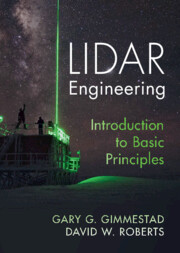Book contents
- Lidar Engineering
- Lidar Engineering
- Copyright page
- Dedication
- Contents
- Preface
- Glossary
- List of Abbreviations
- 1 Introduction
- 2 The Basic Lidar Models
- 3 The Molecular Atmosphere
- 4 Particles in the Atmosphere
- 5 Lidar Transmitters
- 6 Lidar Receivers and the Geometrical Function
- 7 Optomechanics
- 8 Optical Detection
- 9 Data Systems
- 10 Lidar Data Analysis
- 11 Applications
- Appendix A The Klett Retrieval
- Index
- References
3 - The Molecular Atmosphere
Published online by Cambridge University Press: 16 February 2023
- Lidar Engineering
- Lidar Engineering
- Copyright page
- Dedication
- Contents
- Preface
- Glossary
- List of Abbreviations
- 1 Introduction
- 2 The Basic Lidar Models
- 3 The Molecular Atmosphere
- 4 Particles in the Atmosphere
- 5 Lidar Transmitters
- 6 Lidar Receivers and the Geometrical Function
- 7 Optomechanics
- 8 Optical Detection
- 9 Data Systems
- 10 Lidar Data Analysis
- 11 Applications
- Appendix A The Klett Retrieval
- Index
- References
Summary
An overview of optical scattering in the atmosphere includes the sizes and concentration of scatterers, the mathematical formalism of scattering, and definitions of the lidar scattering and extinction coefficients. The Rayleigh, Mie, and geometric scattering regimes are defined by the scattering parameter, and implications of Rayleigh scattering on lidar measurements are elucidated for both signals and background. Molecules store energy in translational, rotational, and vibrational motions, and atoms store energy in electronic excitations. These energy storage mechanisms cause the lidar observables of Doppler shifts, molecular and Raman spectra, and atomic spectra, which, along with Rayleigh scattering, enable lidar measurements of temperatures and winds; water vapor and trace gas concentrations; and aerosol extinction coefficients at altitudes from the surface up to the mesosphere and lower thermosphere. The lidar techniques that exploit all these phenomena operate over a range of wavelengths from the long wave infrared to the ultraviolet and the reasons for the differing wavelengths of the various techniques are explained with a graphic that summarizes the chapter.
Keywords
- Type
- Chapter
- Information
- Lidar EngineeringIntroduction to Basic Principles, pp. 30 - 64Publisher: Cambridge University PressPrint publication year: 2023



